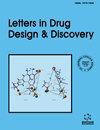Effects of Compound in Hedyotis diffusa Willd against Acute Myeloid Leukemia: An In silico and In vitro Study
IF 1.6
4区 医学
Q4 CHEMISTRY, MEDICINAL
引用次数: 0
Abstract
Background: Hedyotis diffusa Willd (HDW) is an herb that has been used empirically for treating cancer, and its antileukemic effect has been confirmed by laboratory evidence. This study aimed to explore the underlying mechanism by which HDW and its active compound exert effects on acute myeloid leukemia (AML) through in silico analyses combined with experimental validation. Methods: The targets of the compounds were collected from the database and intersected with AML targets. Based on these data, a protein-protein interaction (PPI) network and compound-target (C-T) network were constructed, and KEGG enrichment analysis was performed. Topological analysis of the C-T network and PPI network was performed to screen for hub compounds and targets. Molecular dynamics simulations were conducted to test the binding mode and strength between the targets and the compounds at the molecular level. Cell viability, flow cytometry, ELISA, and Q-PCR were further used to evaluate the in silico results. Results: A total of 86 targets of 12 screened active compounds of HDW against AML were identified. According to topological analysis, tumor protein p53 (TP53) and signal transducer and activator of transcription 3 (STAT3) exhibited the highest degree of centrality (DC) in the PPI networks of HDW targets. Quercetin had a higher affinity for TP53 than for STAT3. Molecular dynamics simulations confirmed that the TP53-quercetin docked complex was stable with respect to the original TP53-ligand complex. The targets of HDW and quercetin against AML were significantly enriched in multiple biological processes, including the p53 signaling pathway and apoptosis. The results from the in vitro experiment confirmed that quercetin triggers apoptosis in the human AML cell line KG-1 through the p53 pathway protein. Conclusion: This study outlines the multi-compound, multi-target, and multi-pathway mechanism by which HDW affects AML based on an in silico predictive model and further validates the antileukemic mechanism of the screened active compound in an in vitro model. This study provides a perspective for studying the antileukemic mechanism of HDW for further research.Hedyotis diffusa Willd 中的化合物对急性髓性白血病的影响:硅学和体外研究
背景:白花蛇舌草(Hedyotis diffusa Willd,HDW)是一种经验性用于治疗癌症的草药,其抗白血病作用已被实验室证据所证实。本研究旨在通过硅学分析结合实验验证,探索 HDW 及其活性化合物对急性髓性白血病(AML)产生影响的内在机制。研究方法从数据库中收集化合物的靶点并与急性髓性白血病靶点交叉。基于这些数据,构建了蛋白质-蛋白质相互作用(PPI)网络和化合物-靶点(C-T)网络,并进行了KEGG富集分析。对 C-T 网络和 PPI 网络进行拓扑分析,以筛选中心化合物和靶点。还进行了分子动力学模拟,以测试靶标与化合物在分子水平上的结合模式和强度。此外,还使用了细胞活力、流式细胞仪、ELISA 和 Q-PCR 等方法来评估硅学结果。结果筛选出的 12 种 HDW 活性化合物共鉴定出 86 个抗 AML 靶点。根据拓扑分析,肿瘤蛋白 p53(TP53)和信号转导和转录激活因子 3(STAT3)在 HDW 靶点的 PPI 网络中表现出最高的中心度(DC)。槲皮素对 TP53 的亲和力高于 STAT3。分子动力学模拟证实,TP53-槲皮素对接复合物与原始的TP53-配体复合物相比是稳定的。HDW和槲皮素针对急性髓细胞白血病的靶点在多个生物学过程中都有显著的富集,包括p53信号通路和细胞凋亡。体外实验结果证实,槲皮素可通过 p53 通路蛋白触发人 AML 细胞株 KG-1 的细胞凋亡。结论本研究基于硅学预测模型概述了 HDW 影响急性髓细胞性白血病的多化合物、多靶点和多途径机制,并在体外模型中进一步验证了所筛选的活性化合物的抗白血病机制。这项研究为进一步研究 HDW 的抗白血病机制提供了一个视角。
本文章由计算机程序翻译,如有差异,请以英文原文为准。
求助全文
约1分钟内获得全文
求助全文
来源期刊
CiteScore
1.80
自引率
10.00%
发文量
245
审稿时长
3 months
期刊介绍:
Aims & Scope
Letters in Drug Design & Discovery publishes letters, mini-reviews, highlights and guest edited thematic issues in all areas of rational drug design and discovery including medicinal chemistry, in-silico drug design, combinatorial chemistry, high-throughput screening, drug targets, and structure-activity relationships. The emphasis is on publishing quality papers very rapidly by taking full advantage of latest Internet technology for both submission and review of manuscripts. The online journal is an essential reading to all pharmaceutical scientists involved in research in drug design and discovery.

 求助内容:
求助内容: 应助结果提醒方式:
应助结果提醒方式:


